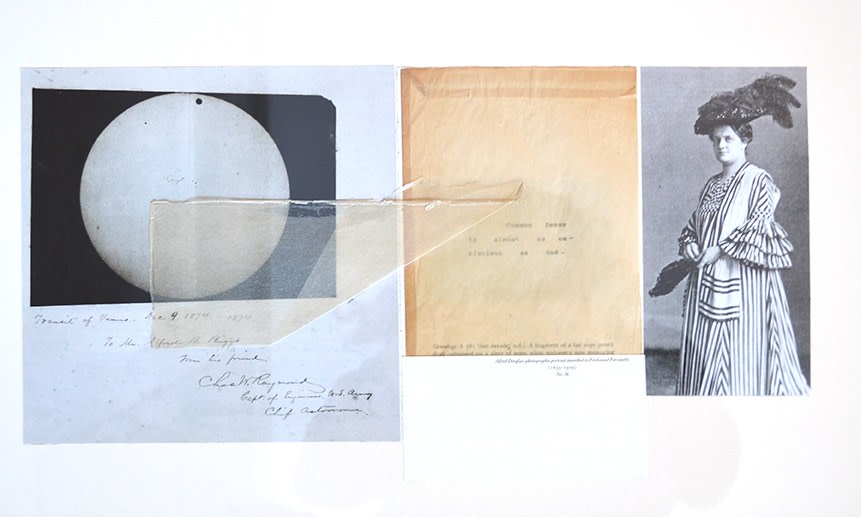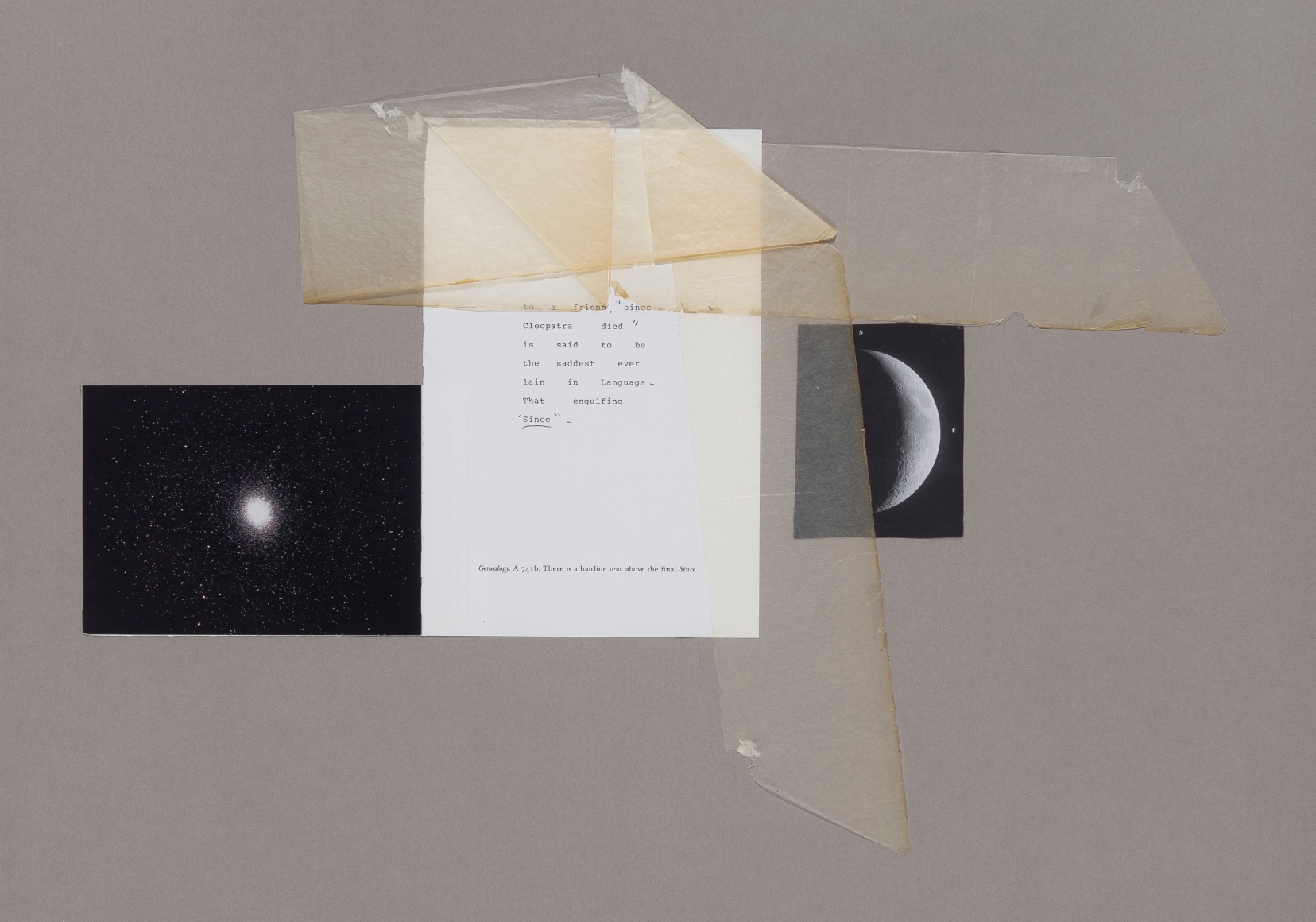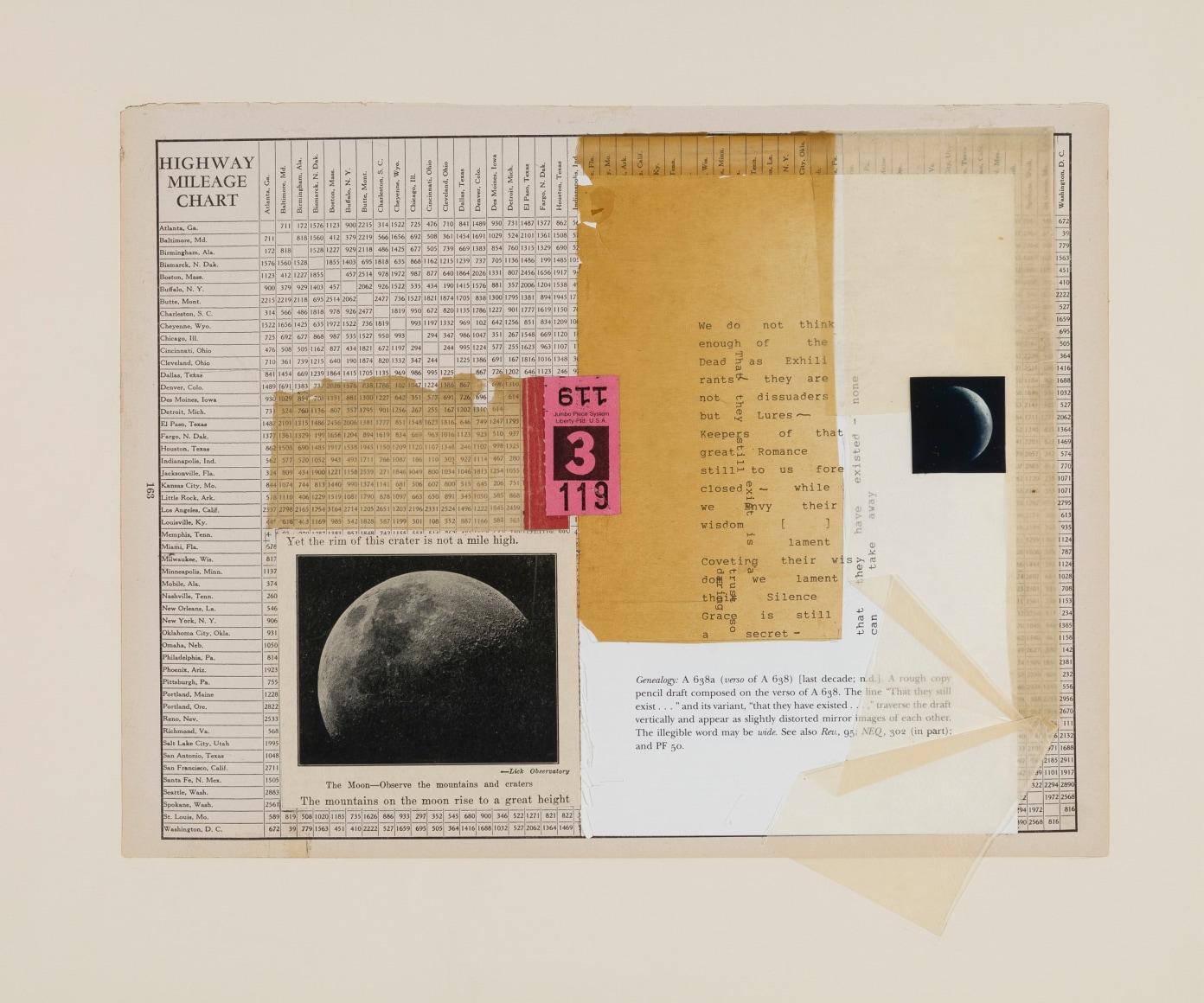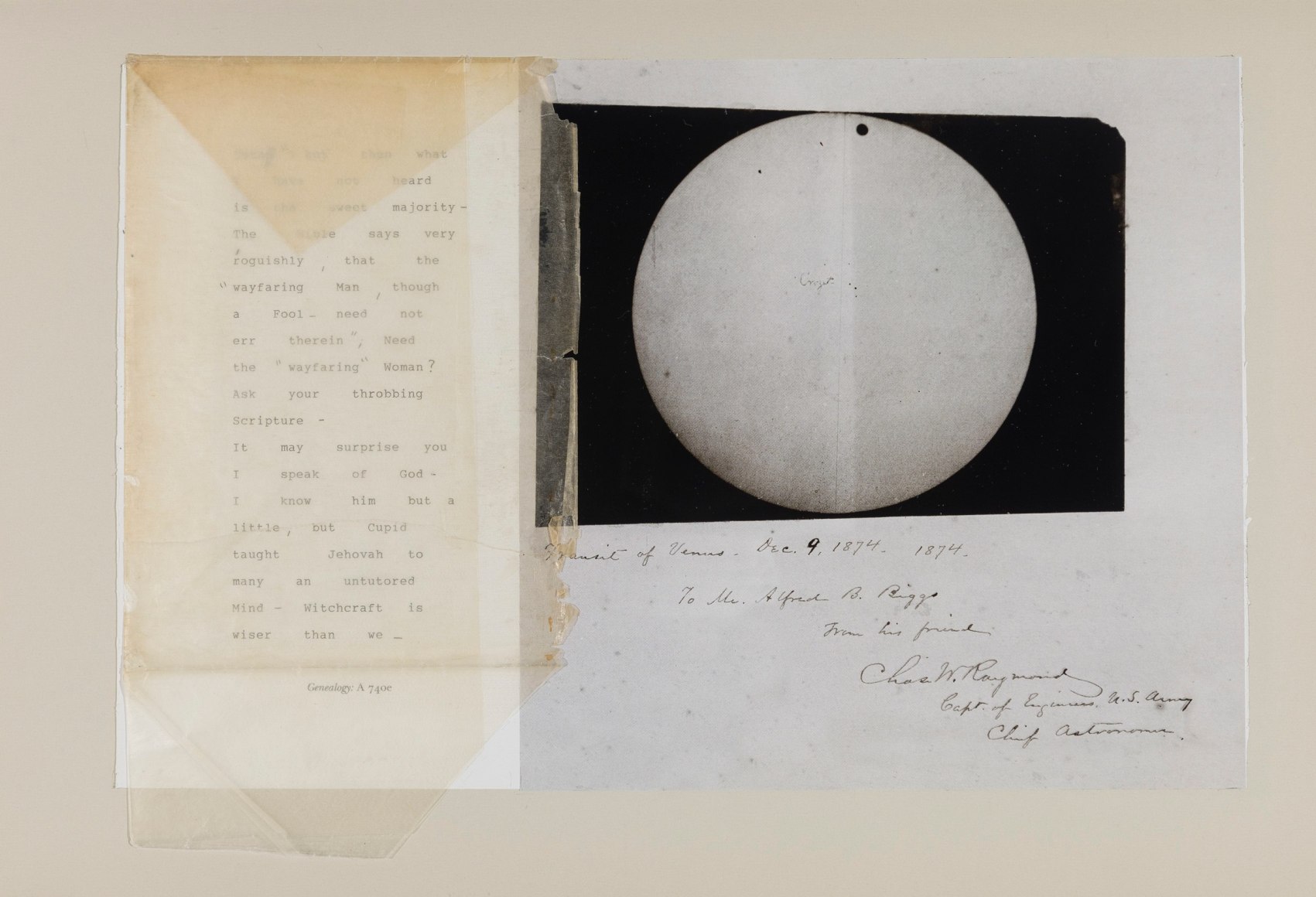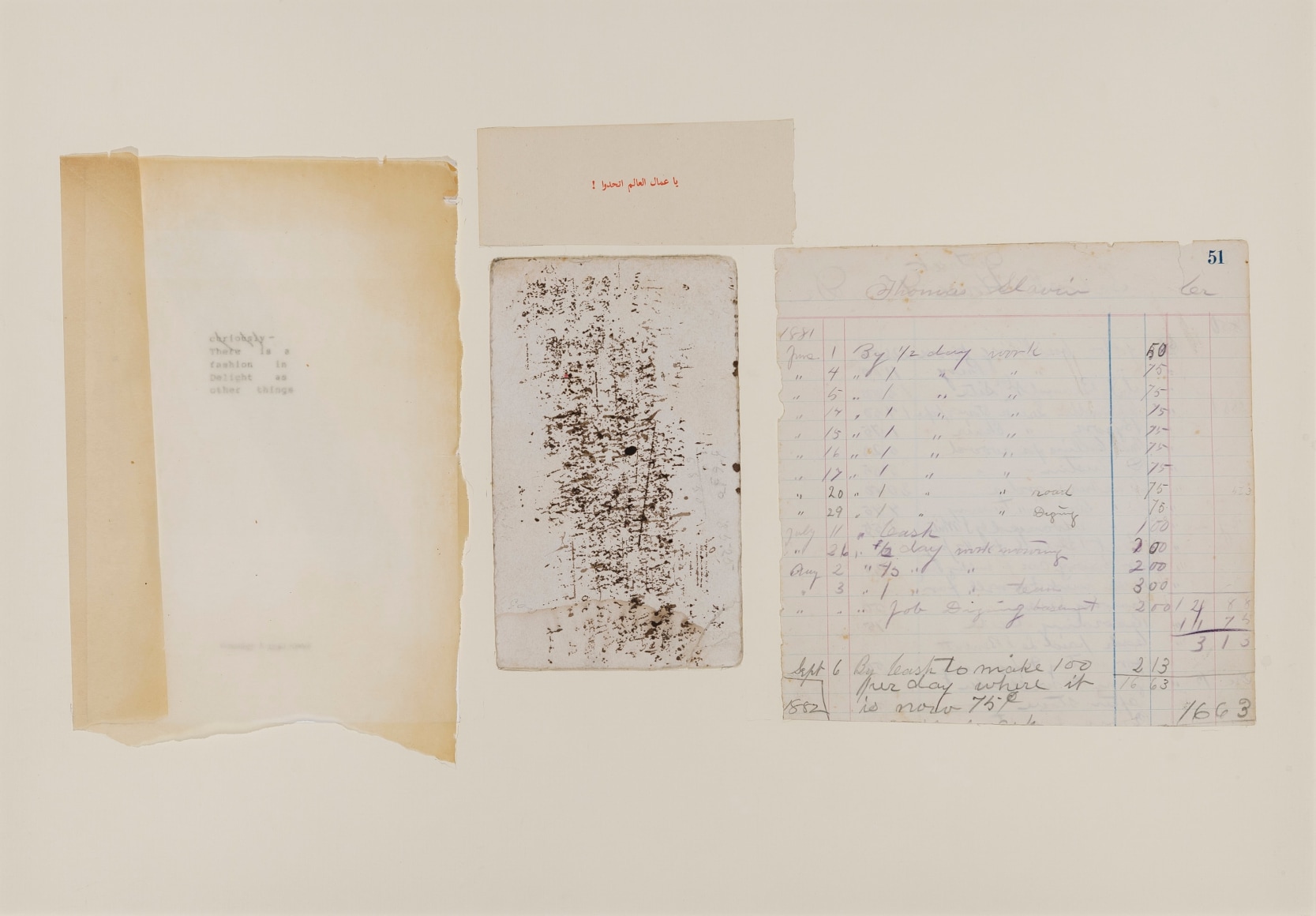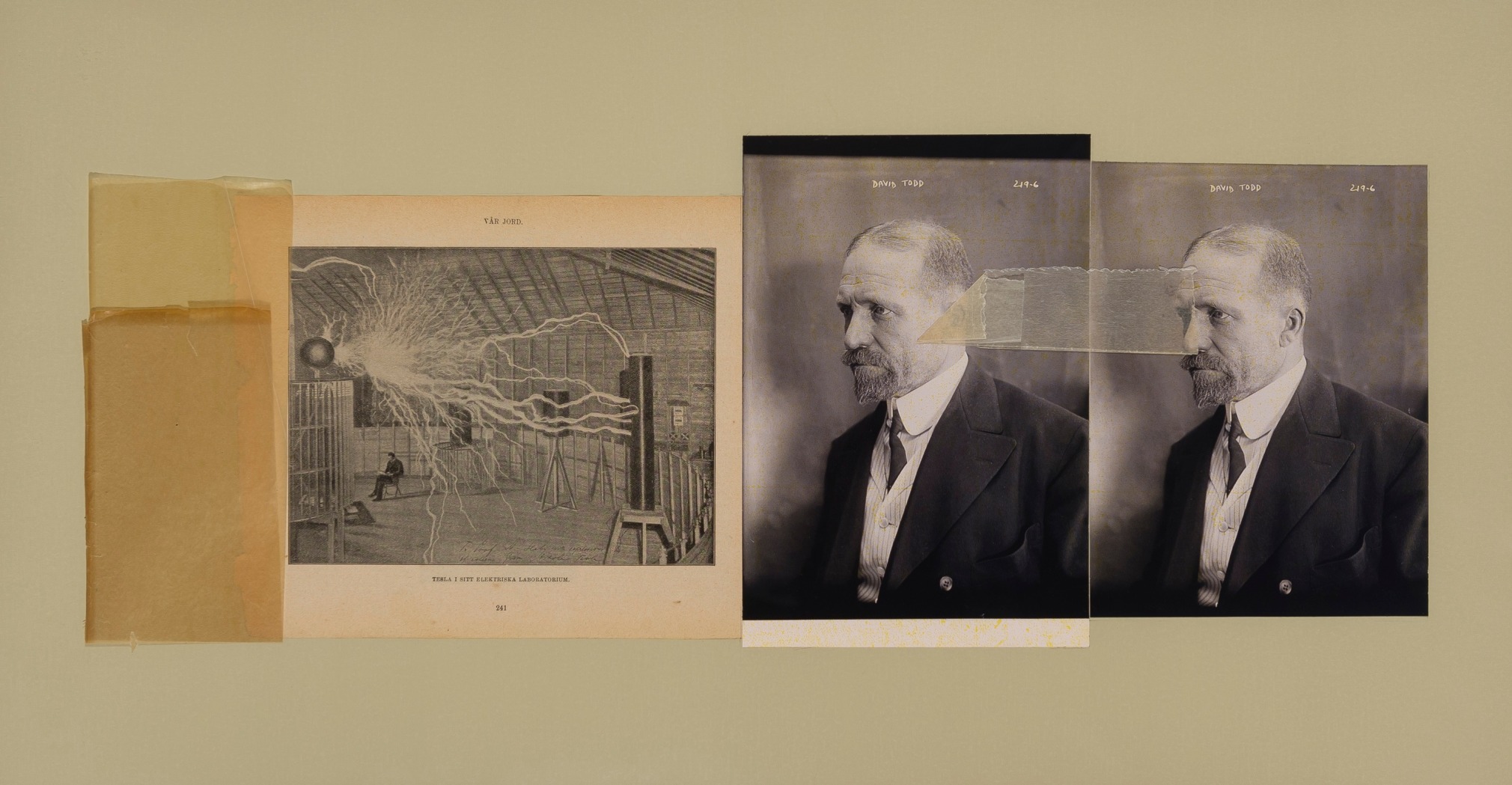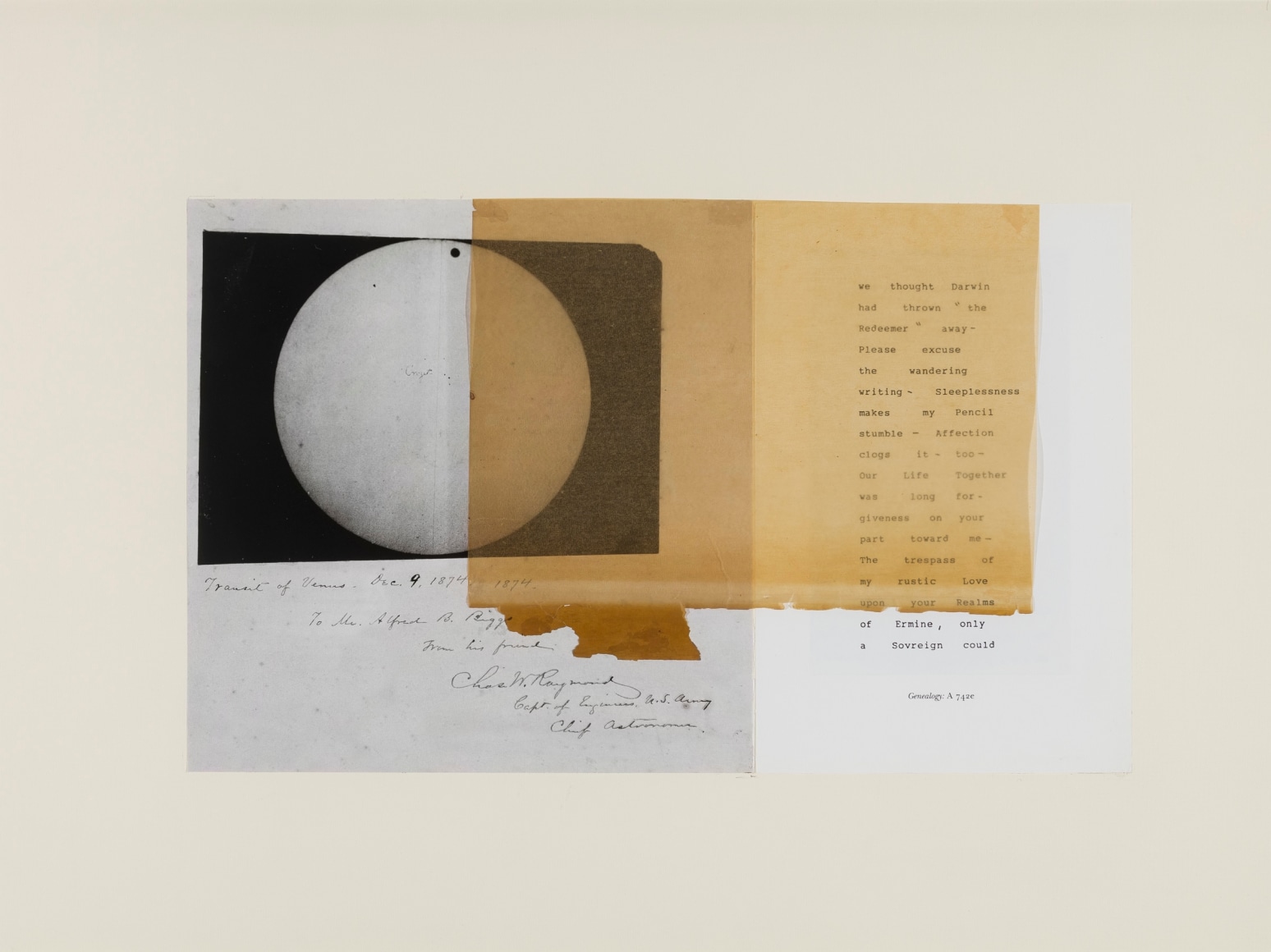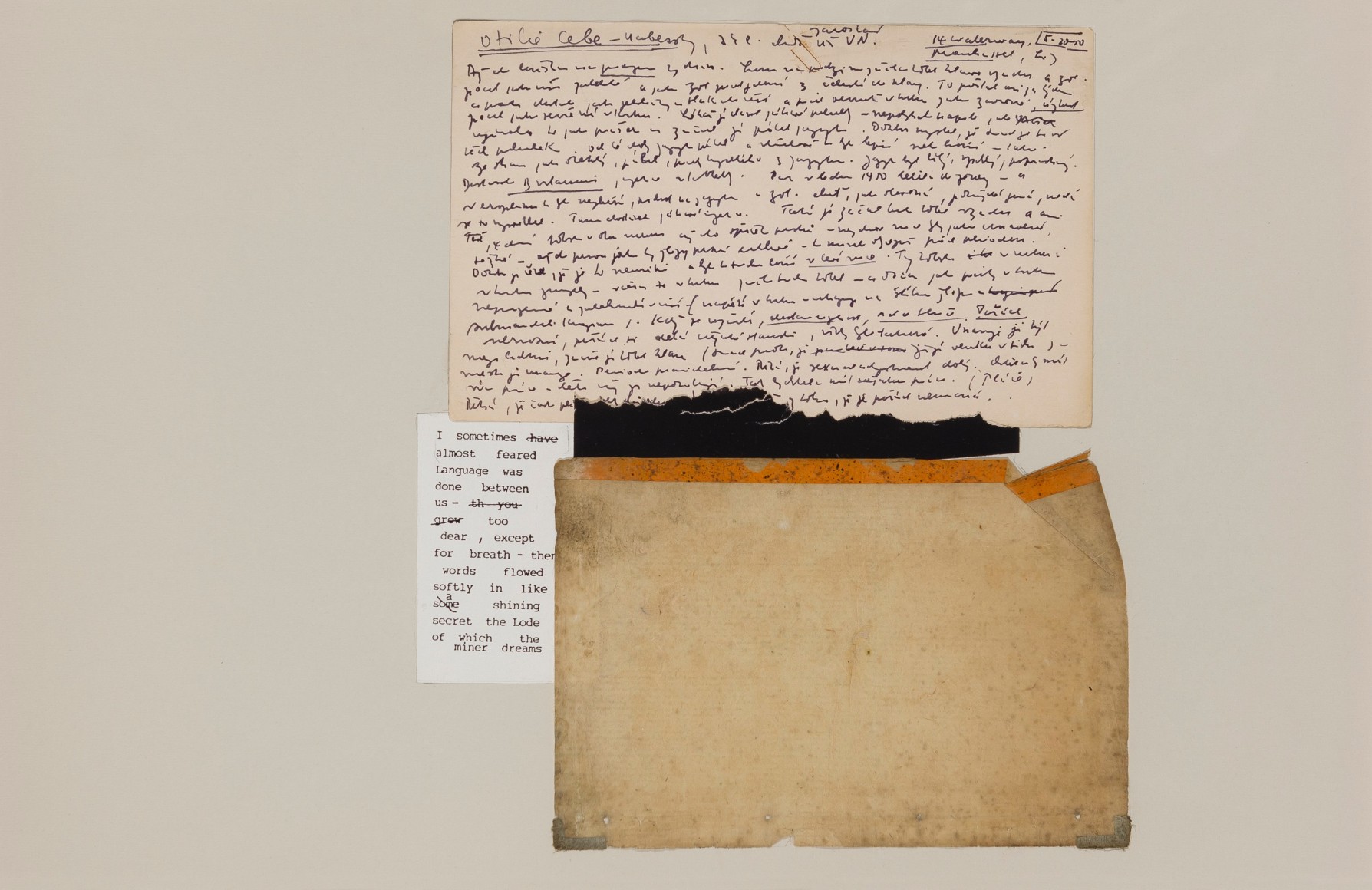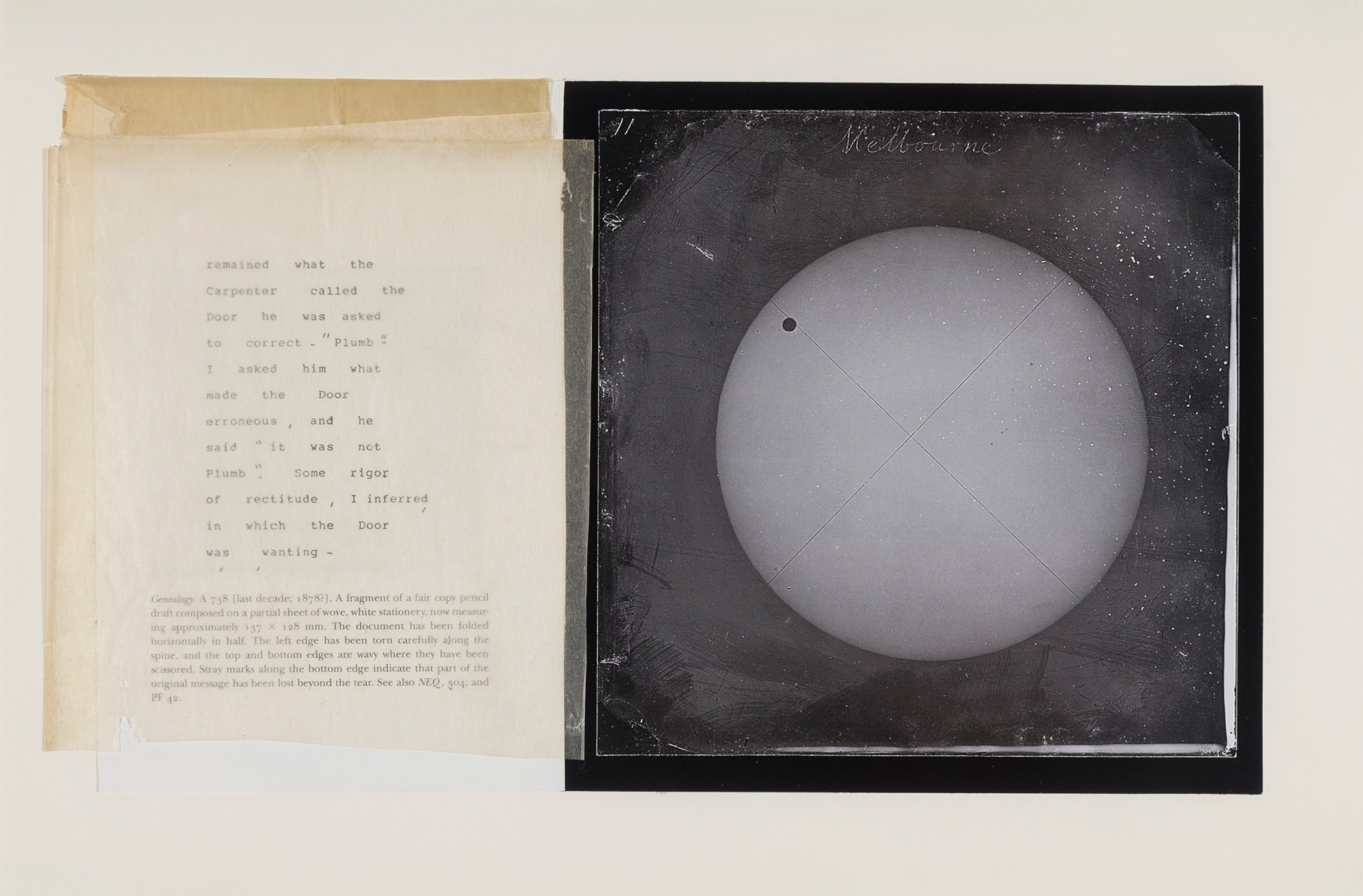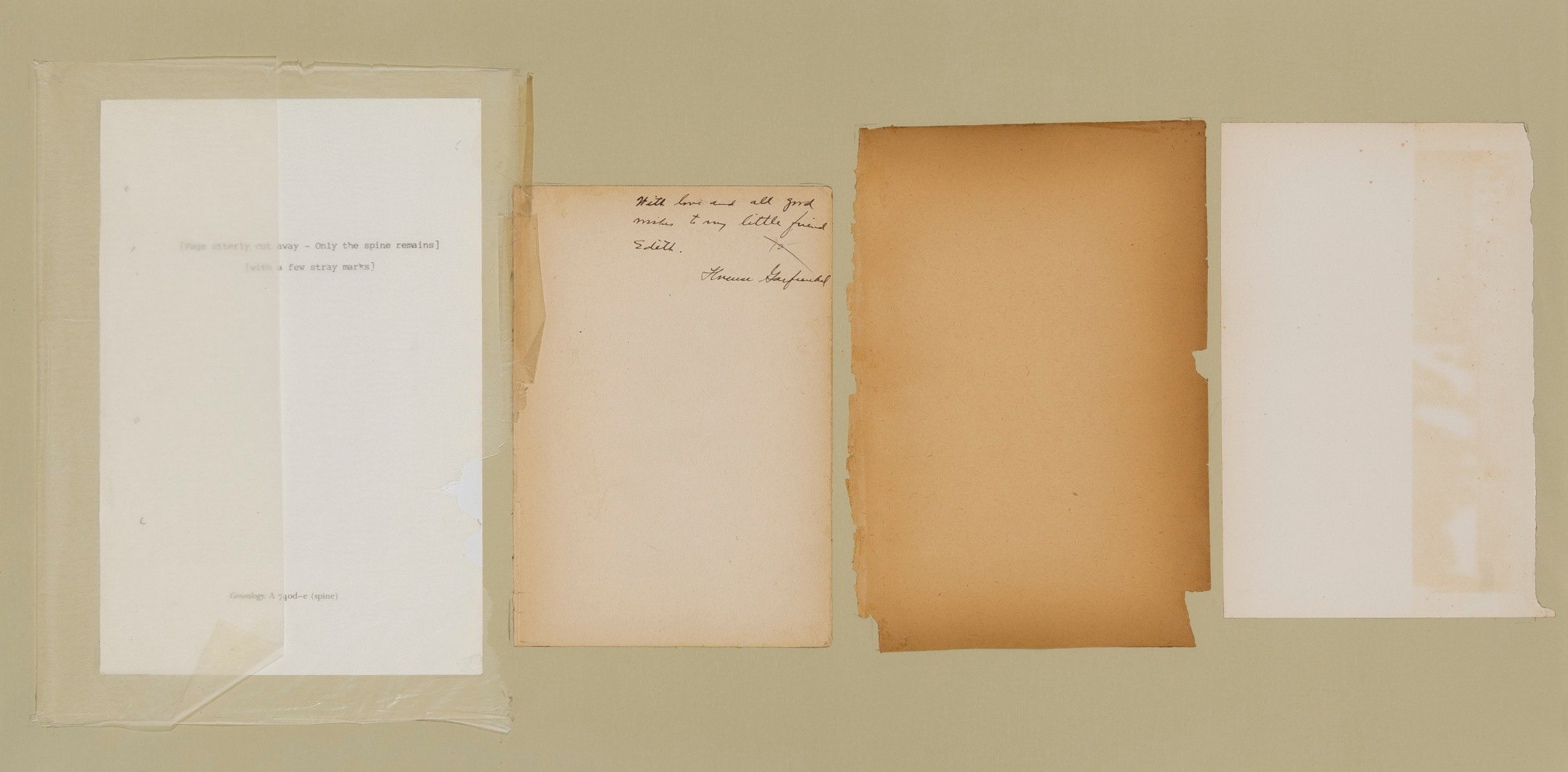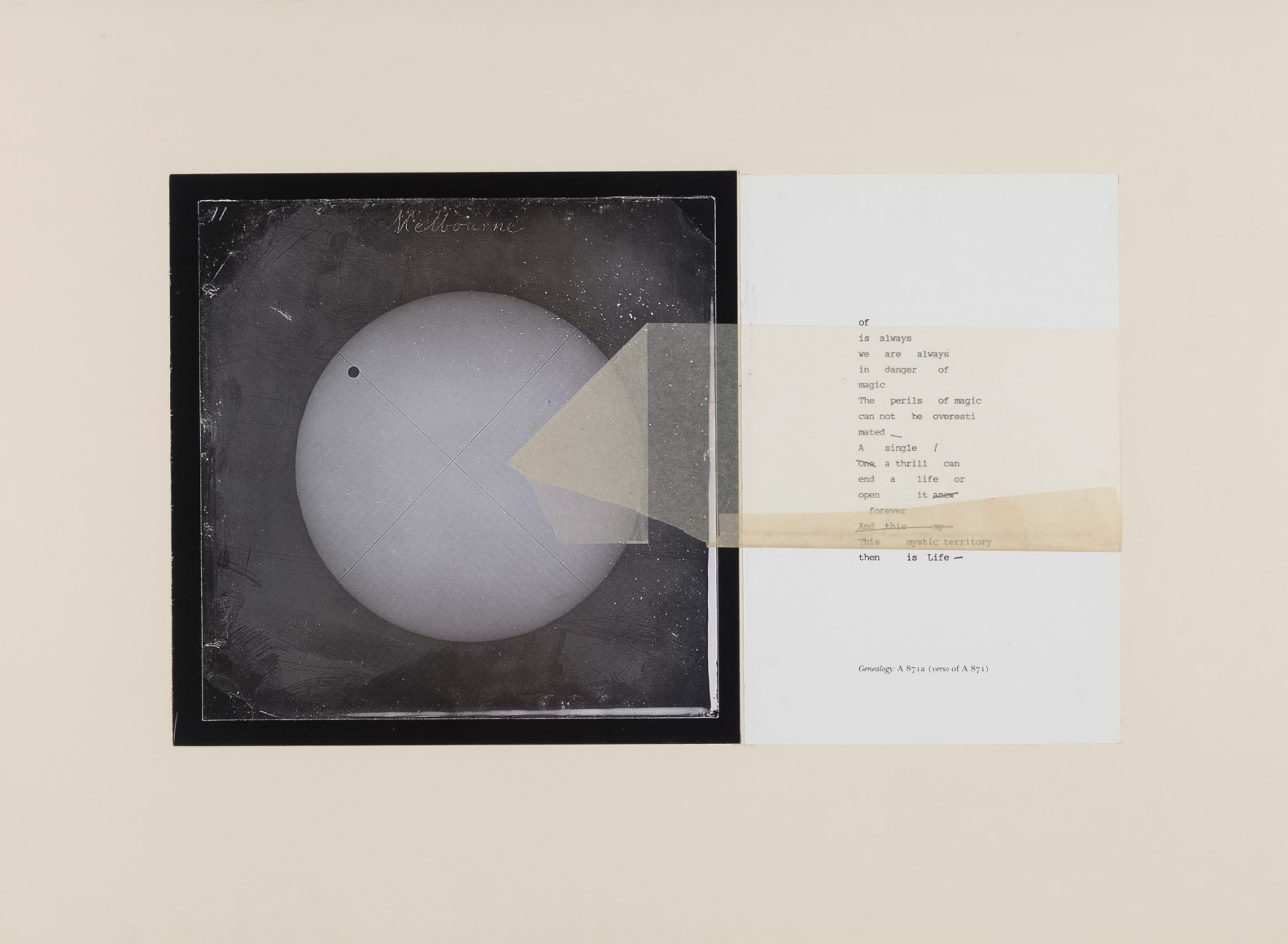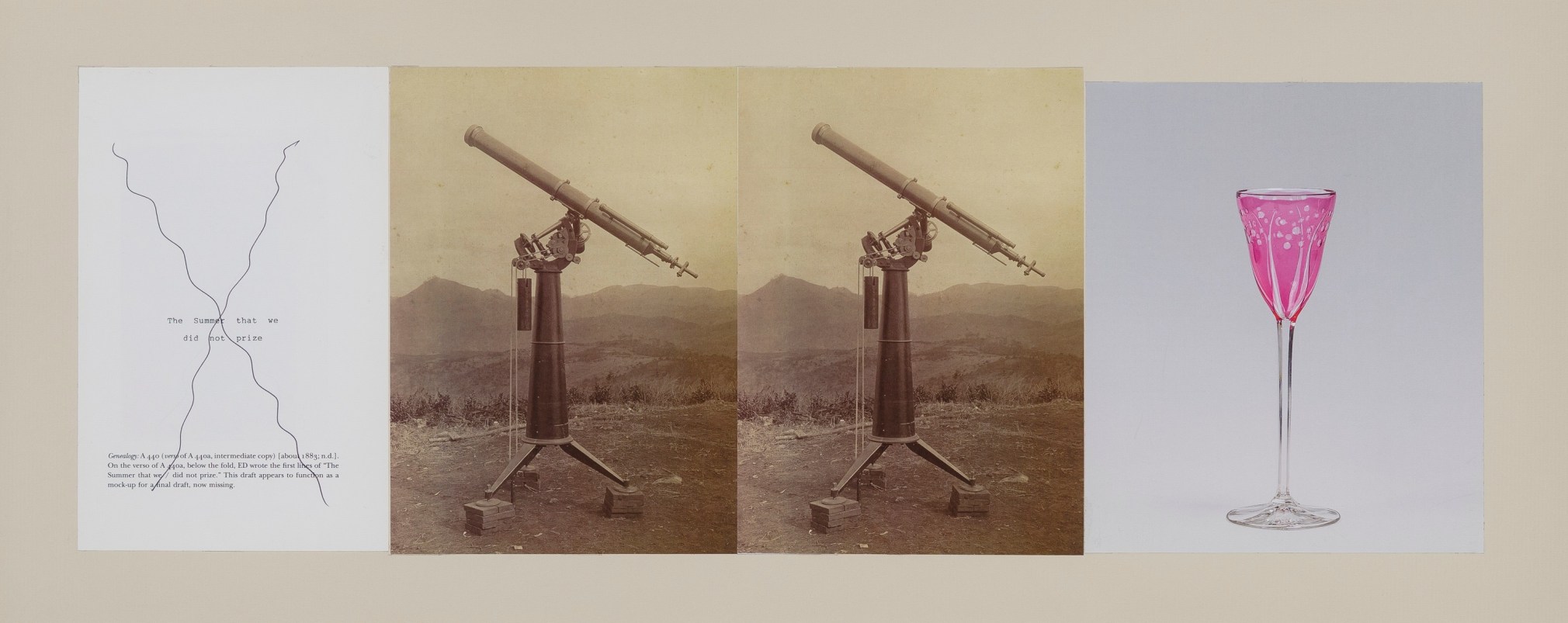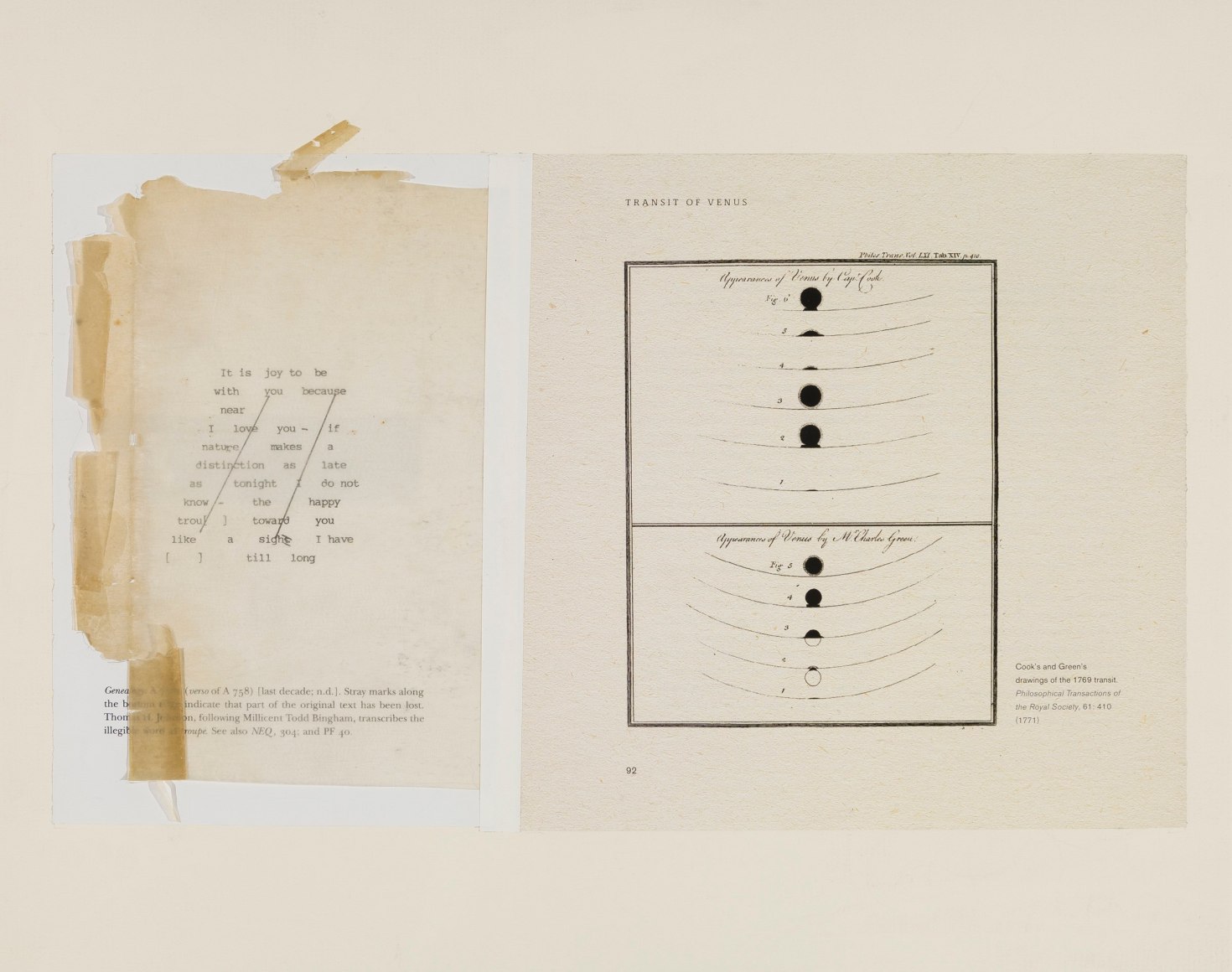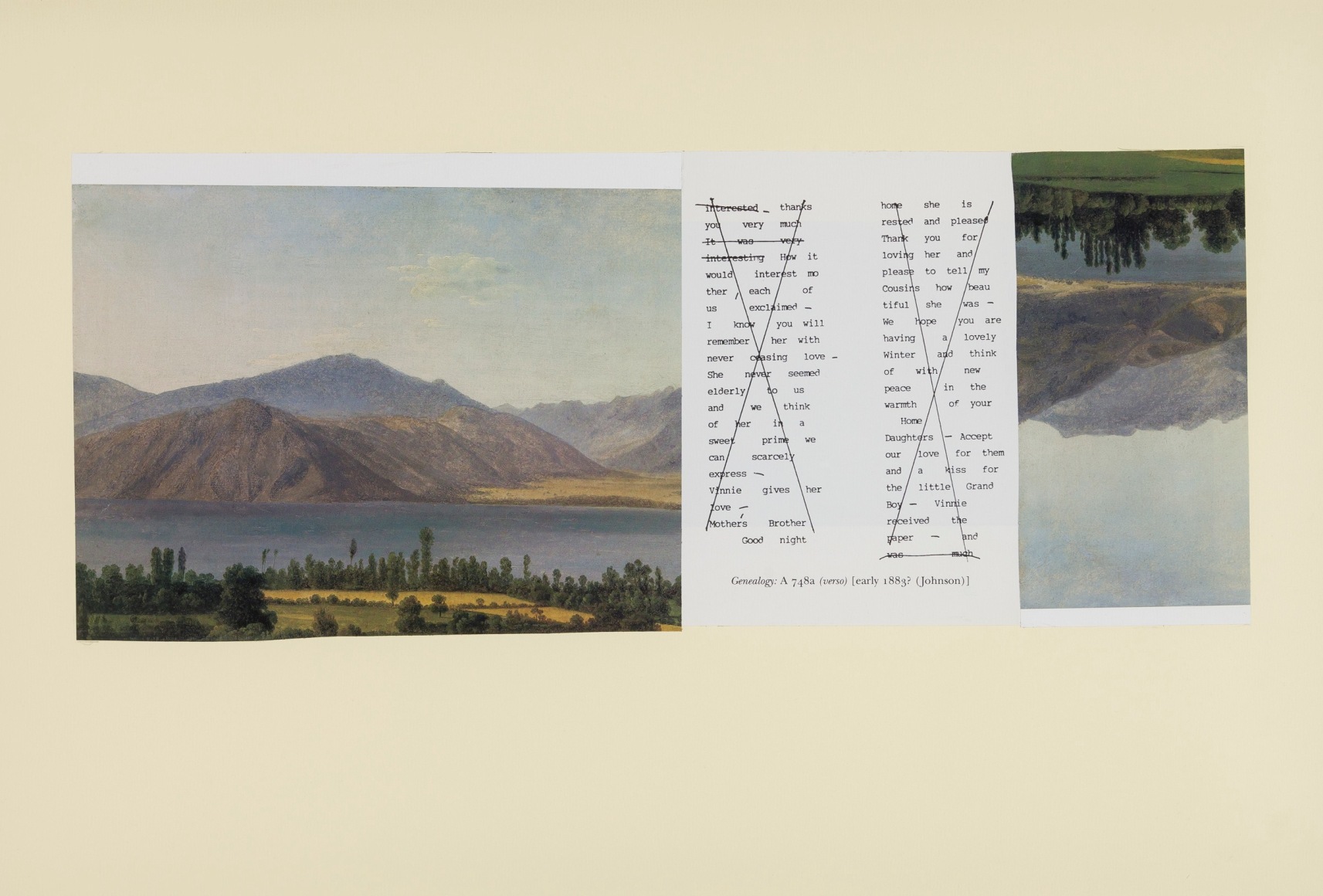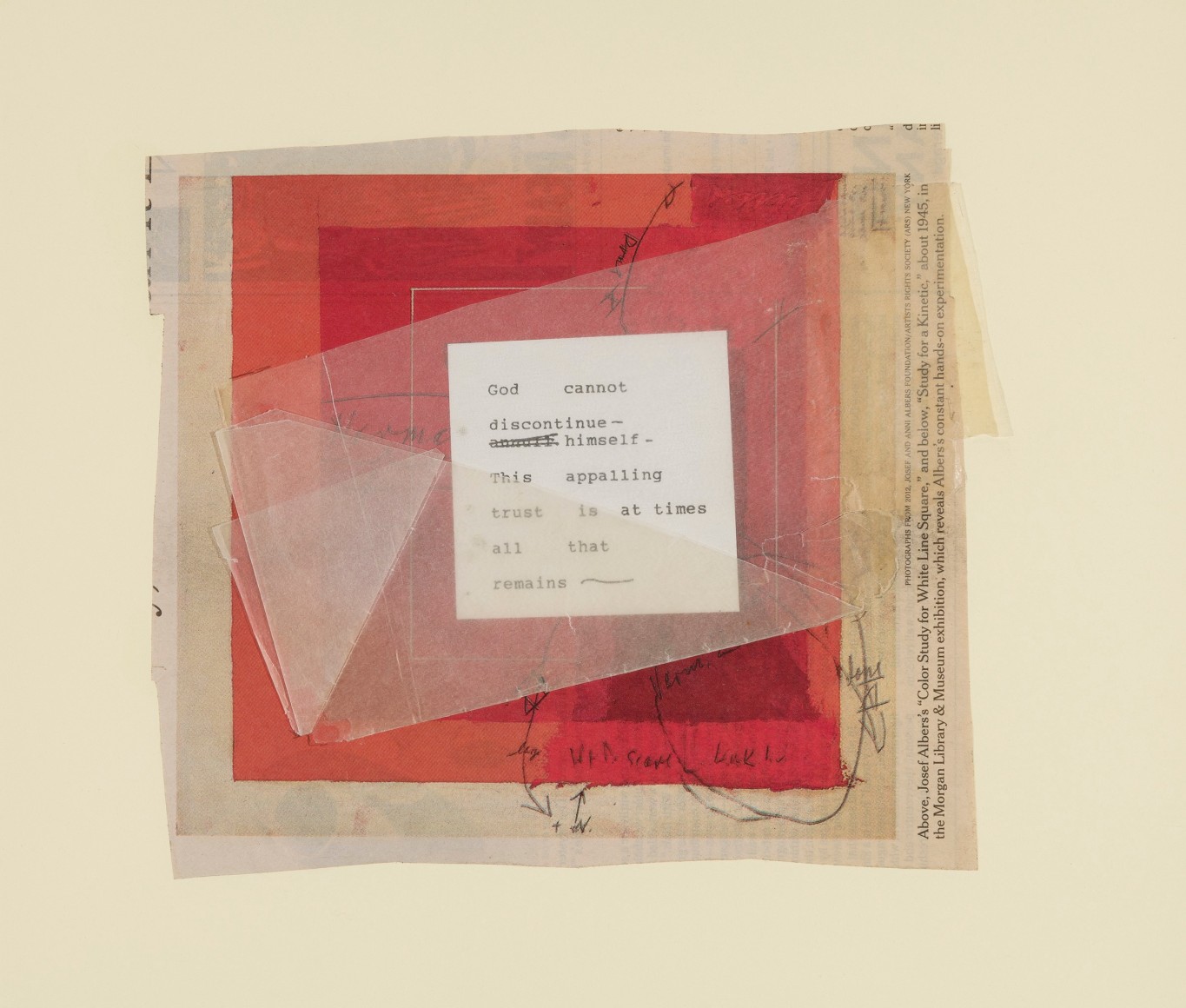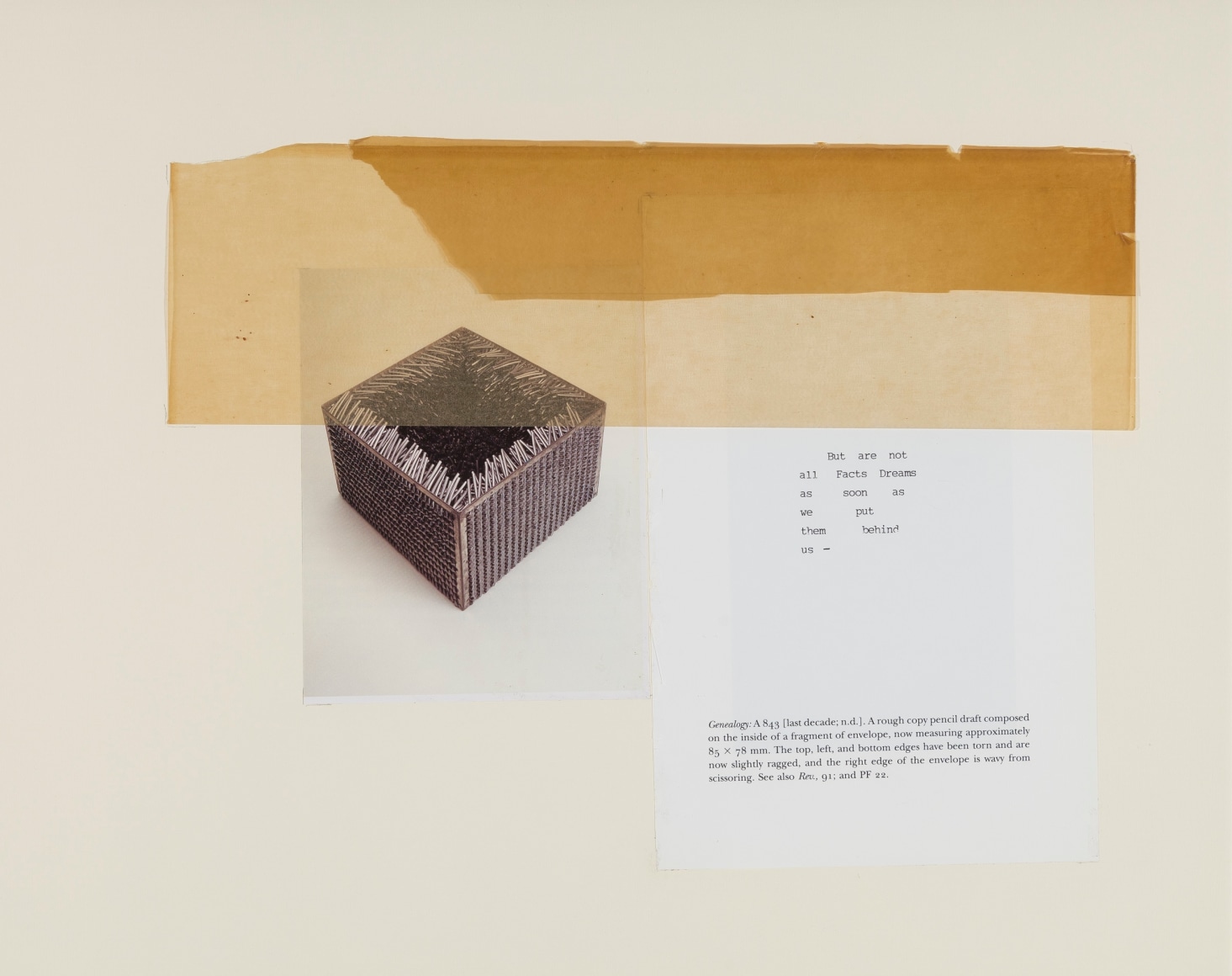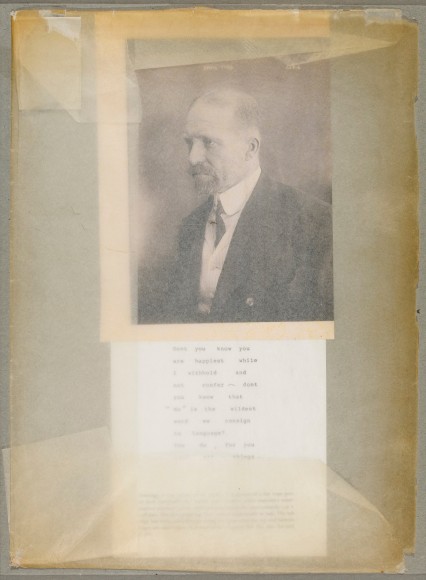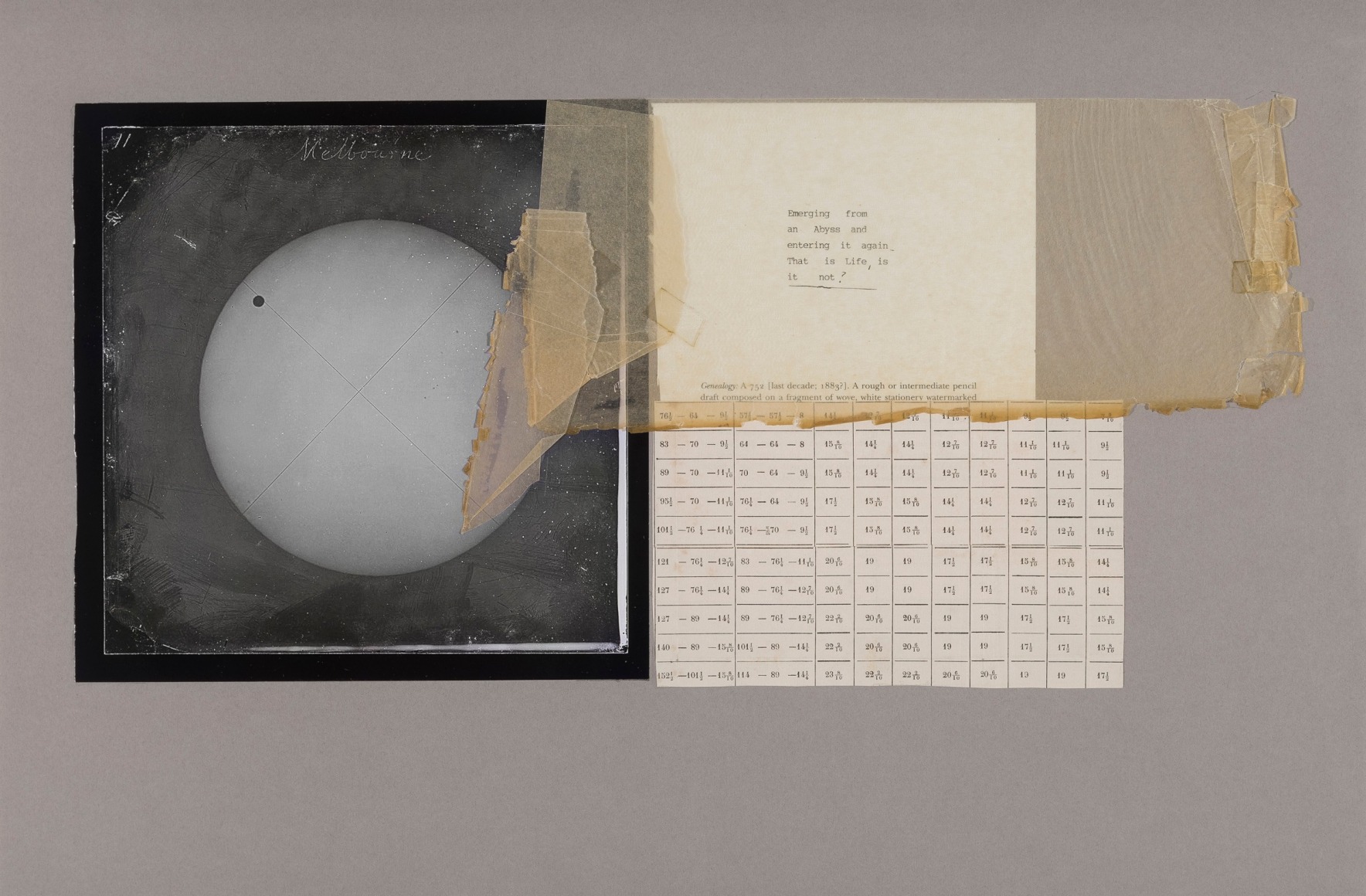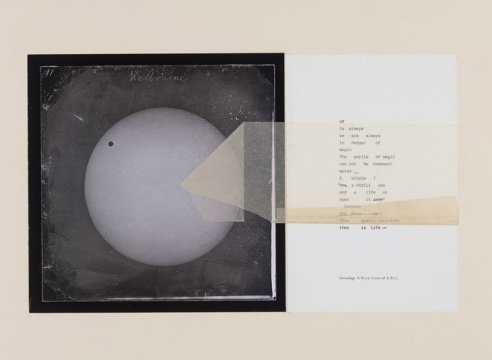
Lori Bookstein Fine Art is pleased to announce an exhibition of new collages by Janet Malcolm. This is the artist’s fifth solo-show with the gallery.
As the title suggests, The Emily Dickinson Series was inspired by the late writings of Emily Dickinson as found in Marta Wener’s Emily Dickinson’s Open Folios: Scenes of Reading, Surfaces of Writing. The publication brings together forty of Dickinson’s late drafts, also known as the “Lord Letters,” and is presented with facsimiles of the original writing alongside the typed transcriptions. In Malcolm’s collages, she reappropriates this text, juxtaposing it against seemingly unrelated visual ephemera. Everything from highway mileage charts to antiquated photographs can be found in this latest series. Most predominately, however, Malcolm combines Dickinson’s writings with astronomical images.
The following correspondence between Marta Werner and Janet Malcolm first appeared in issue 126 of Granta under the heading “The Emily Dickinson Series: A Correspondence.” A version of this text has been reprinted on the following pages with permission.
Janet Malcolm (b. 1934, Prague) is the author of twelve books and a frequent contributor to The New Yorker and The New York Review of Books. In addition to her extensive practice of collage making, Malcolm has produced a series of photographs of Burdock leaves. A catalog of these prints, entitled Burdock, is available from Yale University Press. The artist lives and works in New York City.
Marta Werner is an Associate Professor of English at D’Youville College, Buffalo, NY. Her scholarship resides largely in 19th century literature with a focus on the work of Emily Dickinson and, more recently, the writings of Nathaniel and Sophia Hawthorne. She has authored and edited several books including Emily Dickinson's Open Folios: Scenes of Reading, Surfaces of Writing, and Radical Scatters: An Electronic Archive of Emily Dickinson's Late Fragments and Related Texts. She is also a member of the Emily Dickinson Editing Collective.
Janet Malcolm: The Emily Dickinson Series will be on view from January 9 – February 8, 2014. An opening reception will be held on Thursday, January 9th from 6-8 pm. Gallery hours are Tuesday through Saturday, 10:30 am to 6:00 pm. For additional information and/or visual materials, please contact Joseph Bunge at (212) 750-0949 or by email at joseph@loribooksteinfineart.com.
The Emily Dickinson Series
A Correspondence
Janet Malcolm and Marta Werner
When I first opened Marta Werner’s Emily Dickinson’s Open Folios I felt a shiver of interest and desire such as one feels in an expensive shop at the sight of an object of particular beauty and rarity. I was drawn to the book’s right-hand pages on which typewritten words appeared – words that were wild and strange, and typing that evoked the world of the early twentieth-century avant-garde. These were Marta Werner’s transcriptions of scraps of handwritten prose by Emily Dickinson, discovered after her death. The scraps themselves were reproduced in facsimile opposite the typed transcripts.
The book belonged to my friend Sharon Cameron, a professor and critic and the author of two books on Emily Dickinson that are considered classics in the field. I was at her apartment. She had shown me the book – I forget for what reason – and I asked if I could cut out some of the right-hand pages to put into collages. She looked at me in horror and said, ‘Certainly not.’
I tried to buy the book on Amazon and found it was out of print, and couldn’t find it anywhere else. Sharon Cameron suggested I write to Marta Werner:
18 September 2012
Dear Marta Werner,
I have been trying to purchase a copy of your wonderful book Emily Dickinson’s Open Folios, and have had no success. My friend Sharon Cameron suggested I write to you on the off chance that you had an extra copy I could buy from you, or that you could direct me to a source.
With thanks and best wishes,
Janet Malcolm
Dear Janet Malcolm,
How extremely kind of you to write!
It’s rather strange, I suppose, but I have only one copy of the book.
I believe my Mother has one, too, though, so since there’s one floating about the family somewhere, I’d be happy to send you my copy. I certainly don’t want anything for it.
If you’d accept my copy, I’d be delighted to send it. It seems to belong to another part of my life – I hope I learned from it!
All my best,
Marta
19 September 2012
Dear Marta,
I cannot tell you how moved I am by your offer to give me your only copy of the book. Your generosity is staggering. Of course I accept with enormous pleasure and gratitude. May I, in inadequate return, send you a copy of my book Burdock, a collection of photographs of burdock leaves that grew in the New England countryside? If so, would you send me your mail address? My address is [ . . . ].
With huge thanks and all best wishes,
Janet
Dear Janet,
Thank you so much for accepting the book. It is a small thing, after all, and I fear you will definitely lose in this trade. Please don’t regret it too deeply!
Of course I would be delighted to have Burdock – and it could not come at a better time. I am just starting work on the field notebooks of a rather obscure early twentieth-century naturalist – Cordelia Stanwood – and your photographs – and especially your essay – will press me forward through uncertain beginnings. My address is [ . . . ] It seems somehow rude, or cliché, or some combination of both, to tell you how much I admire your work. But it is true, so I’ll say it anyway, and hope I don’t embarrass you.
Gratefully,
Marta
Dear Marta,
I’m so glad that you know my work and like it. If there is any other book (or books) of mine I could send along with Burdock, would you let me know?
All my best,
Janet
20 September 2012
Dear Janet,
How generous! But I think I have everything!
Open Folios is winging its way to you.
Thank you for taking it . . .
Marta
25 September 2012
Dear Janet,
Burdock is here. It is beautiful.
It came at a strange time. My mother is very ill, and when I look at the leaves – pristine and ravaged at once – I think of her.
She would love them, too, without making the comparison.
Thank you so much.
All my best,
Marta
26 September 2012
Dear Marta,
Your remarkable book has arrived, with your lovely inscription, and, again, I am so very grateful and cannot thank you enough. I am curious about the transcriptions. They look as if they were done on various old typewriters. Did you do them? I am very sorry to hear about your mother’s illness. How hard this must be for you. I send all my best wishes for her recovery.
Janet
27 September 2012
Dear Janet,
I’m so glad the book arrived. The transcriptions are indeed my own – and what a trial! I was working on the book so many years ago – in the early 1990s – and so the possibilities (technologically speaking) were rather limited. And, beyond this problem, far beyond it, was my great uncertainty about what an ‘ideal’ transcript of a Dickinson poem would look like. In the end, I decided I wanted to do a few seemingly contradictory things: call attention to the ‘alienness’ of the transcript – its distance, temporal and iconic, etc. – from the manuscript; show and partly enact the conflict between the regularity of type (or typesetting) and the singularity of the hand; and break down distinctions between prose and verse by insisting on following Dickinson’s physical line breaks. I’m not at all sure these intentions – such as they were – translate to readers, but this was what was in my mind. And I think the spirit of Melville was working in all this too – and a story I heard about Melville insisting on always adding the punctuation to those of his works transcribed by others – his sister & wife. In transcribing Dickinson, the excessiveness of certain letters and marks fought and won over the regularizing typewriter.
And yes, initially I did do the transcriptions on typewriters. My grandfather had an amazing (if worthless!) collection of typewriters, which I commandeered for the occasion. Now I am quite sure I would proceed differently! But honestly, I still do not know exactly how. [ . . . ]
Thank you very much for the good thoughts about my Mother.
When I see her in a few weeks, I will bring Burdock to show her. I am sure she will be moved.
At the end of the book, you mention a particular way in which the original photographs were transformed. Do these photographs in the book look so very different from your originals?
I am sure you have seen Dickinson’s herbarium?
I have a question about an exquisite sentence in your introduction – something about the ongoing project of decontextualization. But I will have to ask it later, since I don’t have the sentence before me. When I read it, it struck me as related to the whole problem (or interest!) of the transcript, and I wanted to pursue it further.
About a year before my Father died, we took up the habit – he started it – of sending each other lists of the numbers of Dickinson poems we liked. We did not comment at all on the selections – simply exchanged them every few weeks over the course of several months. The experience was slightly uncanny, and it struck me last night that one could do such a thing with the burdock leaves. That is, that they might be exchanged as messages. The more I look at them, the more they seem to say – or at least the more I talk to myself.
Thank you so much.
Marta
29 September 2012
Dear Marta,
Many things in your letter – especially the mention of decontextualization – tell me that the time has come to tell you of the special reason why I wanted a copy of your book – namely, to cut some pages out of it and put them into collages. When I saw the book at Sharon Cameron’s house, this desire formed itself in my mind – I began to ‘see’ the collages. It was the typewritten transcriptions rather than the handwritten originals that stirred my imagination. The series I want to make will also use images and charts from astronomical texts. Before starting the ‘cutting’ and ‘scissoring’ (the words leaped out of your text) of your precious only copy, I want to have your permission to do so. I will completely understand if you would prefer I not do so, and will continue my search for another copy.
The way the burdock photographs are printed makes them softer-edged and more painterly. The prints themselves are much better than the reproductions in the book. If you ever come to New York, I would be happy to show the prints to you. Some are at the Lori Bookstein Fine Art and the Davis & Langdale galleries and others are under my bed.
Your use of the word uncanny resonates with me. Doesn’t it apply to our encounter?
All my best,
Janet
Dear Janet,
Oh but of course – cut away! I can think of no better fate for the pages of this last copy of my first book than to become collages made by your hands. And to have as company astronomical texts and charts – that is perfectly lovely. There is one – I think it’s A 742 – which is very torn and cut, I wonder if you will be drawn to it . . . And another – I think A 757? – where one word ‘Last’ is written upside down and under other text. The word last is written in a beautiful, magnified fair-copy hand, the text that covers it is in the small, contracted hand of the working drafts. I wonder so much which ones will summon you. I only wish I had the original typescripts to send you. I moved several times since making them, and each time, things vanished, as they do. I shall search again, and if I find them, I will send them onto you – if only as curiosities.
I would love to see the burdock prints, in the galleries and under the bed, though I would not want to put you to any trouble! As for uncanny encounters – yes – this meeting between us is as you say. And I value it all the more for the attending strangeness. There is not enough of this in correspondences – or friendships.
Gratefully,
Marta
30 September 2012
Dear Marta,
I am so happy that my project has your blessing, and will start work on it today. I will let you know which fragments I ‘appropriate’ as it’s called. The book is in my studio and I am about to go out and buy fresh glue.
With many, many thanks again,
Janet
During the winter, spring and summer of 2013 I made collages that yoked Marta's transcriptions of the Dickinson fragments with images I cut out of store-bought books on astronomy. I had used astronomical images in previous collages – they have great graphic clout – but something in Dickinson's words evoked the night sky. It seemed almost obligatory that images of stars and planets and moons accompany her gnomic utterances. A book called The Transit of Venus, 1631 to the Present, "by Nick Lomb – an illustrated study of the rare astronomical event (it occurs in pairs eight years apart every hundred years) when the planet Venus crosses the disc of the sun and appears on its surface as a black circular dot – yielded a pair of spectacular black and white photographs of the sun made during the transit of 1874. I bought extra copies of the book so I could make more than two collages in which these large, mysterious orbs would figure. I also cut out a photograph of a bearded, depressed-looking man named David Peck Todd, an astronomer who was an official observer of the 1874 transit, and later of the one of 1882. Many of the Dickinson fragments read like excerpts from love letters. The consensensus among scholars is that these fragments derive from drafts of letters Dickinson wrote to Judge Otis Lord, a widower with whom she is believed to have had a romantic – possibly even sexual – relationship when she was in her late forties. I had never seen a picture of Lord, and in my imagination the depressed astronomer became a kind of stand-in for him. In the collage called "No," I put Todd's picture above Dickinson's words: “Don’t you know you are happiest while I withhold and not confer – don’t you know that ‘no’ is the wildest word we consign to language?”
In the summer of 2013 I sent Marta photographs of a few collages, and was amazed to learn that the man I had connected to Dickinson in my fancy was connected to her in actuality. Marta identified him as the husband of Mabel Loomis Todd, who ( with Thomas Wentworth Higginson) brought the genius of Dickinson to the attention of the larger world, by editing and publishing the hundreds of unknown poems found in the poet's house after her death in 1886. Mabel Loomis Todd is commonly referred to in Dickinson studies as the poet's "first editor," but she is remembered for another reason as well: for thirteen years she was the mistress of Dickinson's brother, Austin. The affair began in the third year of her marriage to Todd, and continued until Austin's death. No wonder the astronomer looked depressed! But, no, it appeared that Todd did not mind being cuckolded, and was even – as a close friend of Austin Dickinson and a philanderer in his own right – complicit in the affair. Mabel kept a journal in which her erotic life figured as prominently as her social and intellectual one. In Education of the Senses, the first volume of his series The Bourgeois Experience, Victoria to Freud (1984), the historian Peter Gay quotes extensively from this astonishingly unprudish document, to make his point that the Victorians were sexual beings no less than we are. Mabel wrote about her marital and extra-marital sex life with the unembarrassed enthusiasm of a Frank Harris. She did not take up with Austin because of sexual dissatisfaction – she was the most deliciously satisfied of wives, as her journal documents over and over. Sublime sex with Austin did not replace sublime sex with David – it supplemented it.
When I made the collages I knew nothing of this. Years ago, I had read Peter Gay's book but had not retained the name of his sex-loving diarist. That the pictures I cut out of The Transit of Venus could in any way be connected to Emily Dickinson's biography never crossed my mind. I wrote to Marta and said, "There does seem to be something occult going on here, and I don't think I believe in the occult." Marta wrote back: "I am thrilled to be touched by the uncanny. Like you, I have my doubts about the invisible world, but something strange and lovely may be at work. I did not know of these connections – the Dickinson/Venus transit connections – before I found them in your collages. But I assumed YOU knew." I wrote back: "What are we to make of my NOT knowing?"
Janet Malcolm
New York, November 2013

